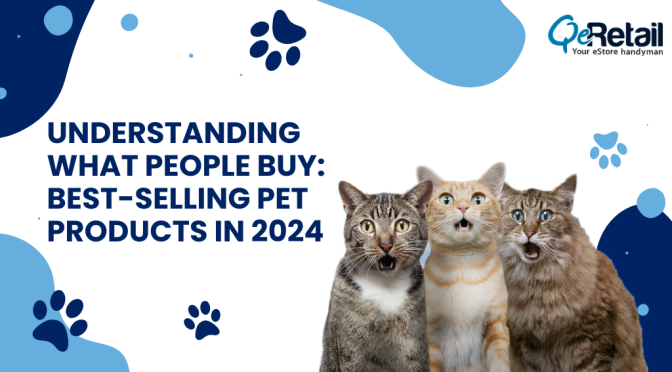Have an eCommerce site with low conversions? Don’t worry. I’ve got you covered.
In this post, we’re going to be covering several advanced eCommerce conversion tactics.
-
Table of Contents
Allow shopping via social media platforms.
Anyone who shops online is also bound to have a social media presence online.
Simply creating an organic presence on Facebook and Instagram for your brand won’t be enough to target these users. As an eCommerce brand— trying to maximize sales with these channels’ help should be your goal.
This is especially true for content that typically earns shares on social media.
For clothing, fashion, or food industries that heavily rely on looks, Pinterest and Instagram profiles should be shoppable. Based on how appealing the products look, users may have a sudden urge to shop those products.
One way to improve the eCommerce conversion rate is to make it easy for a visitor to become a customer. How? By giving followers an option to purchase as they scroll through their feed.
Only this results in sustained growth.
How to Use social selling on social media sites
Set up a business account
On any social media channel, social selling involves upgrading your personal account to a Business account. With this, you get access to more features like analytics and ads.
Brand your account
The account you create should be easy to recognize as a brand account.
The profile photo should be a high-resolution image of your brand’s logo. The bio should match what you have on other sites, and the contact information should be up to date. According to Systeme.io, marketers like Neil Patel are successful because of how they brand themselves on social media.
Link and verify your website
Link and verify your business site. There is an option to add your site on the profile settings, and then the platform proves it. Verified accounts indicate a blue tick and blue subheading that says “verified account” below the profile. Look at the example from Williams Sonoma, where they have their verified site on their profile.
How to sell on social media sites?
These are the basics. Now let’s start making money on social media channels.
Here are the top tips that you must use to use the visual platform to improve eCommerce conversion.
1. Create quality visuals
Pinterest, Instagram, and other social media channels run on visuals. Visuals help you increase sales. The images you post need to be appealing and invite clicks to make this happen.
To do this, you need:
- Quality photography
- Well-designed graphics
- Visuals are sized for each platform.
- Use of bold colors
- Color choices and graphics that match branding.
These graphics will help draw visitors in and let them save and click and finally purchase what you are selling.
One more way is to create a graphic and overlay it with text, so you provide critical information about the product alongside.
You could also use QR codes on social channels. For that, use a custom QR code generator like Beaconstac.
2. Use SEO
Social media sites are good visual search engines, which implies that search engine optimization rules apply here as well.
Focus on industry-relevant keywords (you can find this with SEMrush) and use them in pin titles and descriptions. There are free SEO tools as well.
Adding keywords naturally into descriptions and as hashtags improve the reach of your account. If you’re too busy for this, you can use several social media management tools to make this happen.
3. Use Rich Posts
Rich pins and Tweets on Pinterest & Twitter, respectively, get data from your website and display this along with the standard pin information like photo title, description, and other details.
It adds price and product descriptions for users to view the information on the channel itself.
For instance, on mobile, rich pins enable the shoppable blue button to add your product to the cart and checkout from within Pinterest itself. By making the checkout, seamless users don’t have to create an account on another site or deal with the hassle of saving passwords. You can read more about this in this Keeper review.
4. Use promoted posts
With an organic reach that relies on SEO, you will only see modest gains in the number of views and shares.
That’s where ads come in. You can use ads to directly promote products or send visitors to your site and convert them to leads.
These promoted pins translate to more sales because they can directly take visitors to sites.
2. Be as Informative as Possible for Product Descriptions
Here’s another tip. You want potential customers to trust you when buying from you. Product descriptions give customers a big reason to trust you and must be included. Know that visitors to your site can’t see or touch the products. So you make up for that with the help of images and wordy descriptions. Product descriptions should touch on different aspects of the product, covering product makeup, what differentiates the product from the competition, the sizes and dimensions, and other relevant details.
It’s necessary to provide several visuals of the product on the product page.
Anyone who wants to purchase this item but doesn’t know where to start has now got a fair bit of idea on where to begin after reading the succulent product description. Argan oil is a wellness product, and anyone who wants to buy it has several reasons to justify the purchase. You can also use product explainer videos on product pages.
Ideally, the page should communicate the product’s best features essential to the customer.
Include FAQs
Yet another thing you can do to improve eCommerce conversion is to provide visitors with a rich FAQ section.
Supplement the FAQ section with questions that you regularly get from customers via mail or from the support forums around the product. Collecting such user feedback is critical to success. Why is this necessary? Providing customers with more information about products only helps you draw them closer to the purchase.
In the spirit of being informative, you should also do another thing. Disclose all shipping and cargo handling charges at the outset.
Here’s why.
If we examine the reasons behind why someone chooses to abandon checkout, we can see that extra costs like shipping and other fees are the number one cause. Another popular explanation is unexpected costs. Nearly 90% of the reasons add up to unexpected or extra charges.
The costs you hide and prevent customers from seeing up until the last minute are the biggest reasons why someone decides not to purchase from you which in the end, affects your overall eCommerce conversion rates.
To avoid this, the only thing you need to do is show the customer’s total costs at the start itself.
Don’t hide these fees from customers. It doesn’t bode well from your brand. It results in shopping cart abandonment. And customers begin to trust you less. In the above example, Macy’s discloses the exact order amount at which a customer starts getting free shipping in addition to offering a promo code.
3. Use Scarcity and Urgency to your Advantage
Urgency and scarcity are useful tactics that can help attract attention from customers. However, when it comes to practically implementing these ideas, they differ a little. With the scarcity principle, you’re saying to the customer that only a few items are left in stock. After which, they’d have to wait a long time for the products to be back in stock.
Lulus, a popular retailer in the US, uses urgency by highlighting how many items are left. In addition to informing prospects about low stock levels, they encourage purchase by adding a discount coupon. Notice how the logo is on the top right-hand side of each image. They make sure the branding remains relevant through and through. You can use a free logo maker to make this happen.
Using the urgency principle on products, we’re putting an expiry for the discount or added benefits like quick shipping.
This spurs action.
The tactic is great for the holiday season because there are only a few days left to the holiday, and people want the product shipped.
The simple message that if you(customer) need the products by the holidays, you need to act now spurs a lot of action.
In the cases above, what you want to convey to the customer is clear. If you don’t act now, the opportunity is gone for good.
Scarcity example
Here’s another example. Marcus Taylor (Venture Harbor) created a Groupon-like deal exclusively for musicians. The idea was to group thousands of dollars worth of products and an endorsement deal and sell the package for just $69.
Not only was the deal time-limited, but there were also only 5000 such combos available, after which the deal would never be made public again.
Let’s look at the variations Marcus tested for the deal:
Variation #1:
Variation #2:
In variation #2, the landing page showed how many people had purchased the combo deal and how many combos were left.
For variant #2, the landing page also displayed a prominent countdown timer. Here the conversion rate was 300 percent more than the conversions for variation #1.
Tools like Unbounce make it easy to add countdown timers.
What’s the lesson here?
Give prospects a good reason to make their purchase immediately. As seen in the example above, urgency and scarcity can help.
Present the opportunity in such a way to the customer that it seems more valuable to the customer to make the purchase right at this second.
Appsumo deals work on the same principle. They offer lifetime deals for products that would have otherwise been way too expensive. As a result, people grab them immediately.
The idea finds its origins in loss-aversion. Anyone is more motivated by the thought of losing something and will do anything to prevent that loss. Your customers are no different.
Showing limited stock quantities on pages implies that the product sells out quickly and creates the fear of missing out on.
Different Types of Urgency
In eCommerce, there are different ways to use urgency the right way to generate more sales.
Different sites tend to capitalize on this sense of urgency in different ways.
One of these popular ways during the holiday season (as mentioned before) is to get customers to order by a deadline to get the product before the holidays. This is in full steam now, thanks to Valentine’s day.
Shipping by a specific date if ordered within a particular time frame is one way you can nail urgency.
Low stocks aren’t a significant advantage to a retailer, but most sites turn that to advantage by notifying that the items are about to be over, pushing purchases, and buying quickly.
Another way to use the sense of urgency is to send last chance emails that show that the offer is about to end.
Here’s an example from Google promoting its Pixel offerings on Black Friday. Similarly, during Black Friday and Cyber Monday, SEMrush sends out mailers announcing huge discounts on the product. More often than not, these discounts end within the day itself.
Conclusion
These are some of the best ways to improve eCommerce conversions and, in turn, sales by capitalizing on the sense of urgency, on personalization, and by being more informative. Make it part of your site’s project management. Do let us know what you think of the tips and tricks.
eCommerce conversion. eCommerce conversion. eCommerce conversion.
George is a writer and blogger at Thinkingne.com and at Kamayobloggers.com sites he started to share cutting-edge information around Conversion Rate Optimization and Marketing. He has over 9 years of experience writing online.







